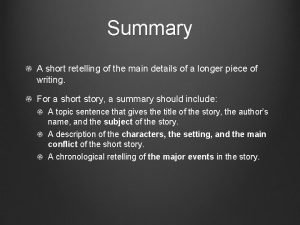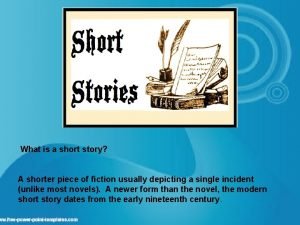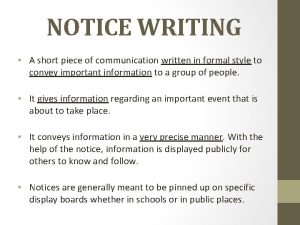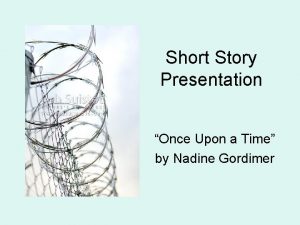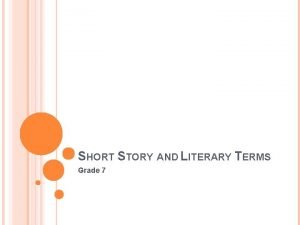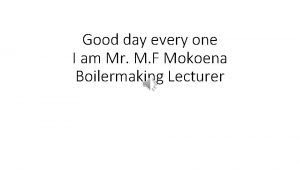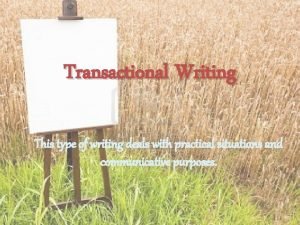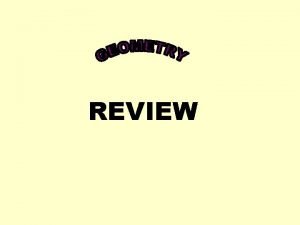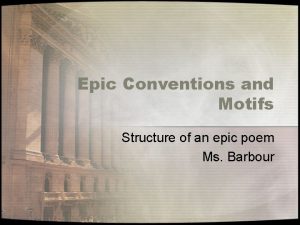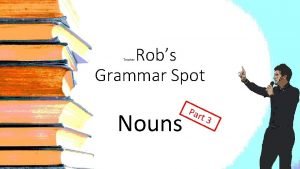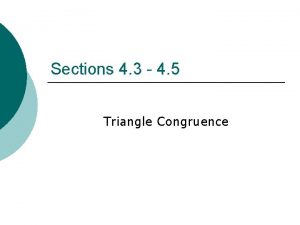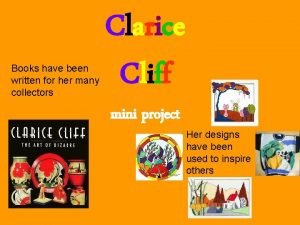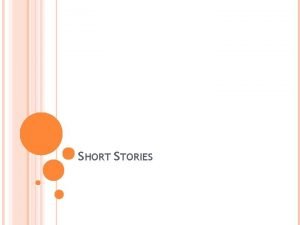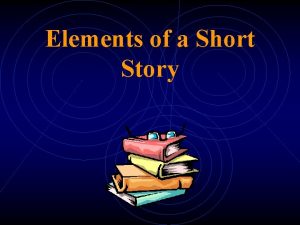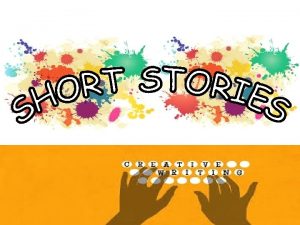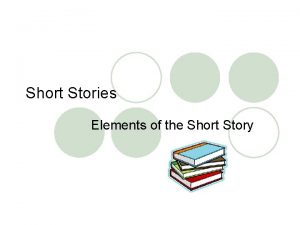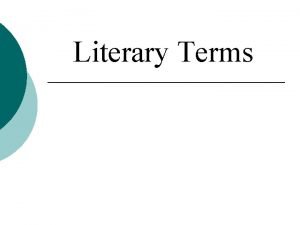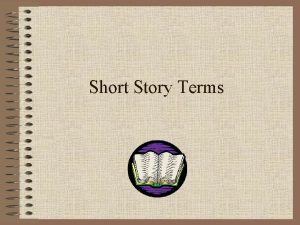What is a short story A shorter piece













- Slides: 13

What is a short story? A shorter piece of fiction usually depicting a single incident (unlike most novels). A newer form than the novel, the modern short story dates from the early nineteenth century.

Setting is the TIME AND PLACE (location) in which the story takes place. What setting can entail: a) place - geographical location. Where is the action of the story taking place? b) time - When is the story taking place? (historical period, time of day, year, etc) c) weather conditions - Is it rainy, sunny, stormy, etc? d) social conditions - What is the daily life of the characters like? Does the story contain local colour (writing that focuses on the speech, dress, mannerisms, customs, etc. of a particular place)? e) mood or atmosphere - What feeling is created at the beginning of the story? Is it bright and cheerful or dark and frightening?

Characters Protagonist (Main character) Are they always the hero? Dynamic character Undergoes change in personality, attitude, beliefs, etc. Tend to be more complex in comparison to other characters. Antagonist (Character in conflict with the main character; sometimes also called the “villain”) Does an antagonist always have to be a ‘bad’ person? Flat or static character Does not change throughout the story, remains the same. They may not have as much depth to their personality.

What are the elements of a short story? Most have a specific plot structure with the following: 1) EXPOSITION 2) RISING ACTION 3) CLIMAX 4) FALLING ACTION 5) RESOLUTION, also known as the denouement

1) EXPOSITION (Introduction - The beginning of the story where the main characters and the setting is revealed). Often in an introduction there will be an… Inciting Event/Incident- An “exciting event” that creates the conflict/problem in a narrative 2) RISING ACTION - This is where the events in the story become complicated and the conflict in the story is revealed (the problem). The rising action is comprised of the events between the introduction and climax. 3) CLIMAX – turning point or the highest point of tension in the story with more interest and suspense 4) FALLING ACTION – the events that lead up to solving the problem or conflict of the story 5) RESOLUTION or denouement– the ending, which includes a tying up of loose ends to the complications built up in the beginning of the story (mysteries are usually solved, questions are answered, and the main conflict is often settled)

Elements of a Short Story - Diagram

Conflict There are two types of conflict: 1) External - A struggle with a force outside one's self. 2) Internal - A struggle within one's self; a person must make some decision, overcome pain, quiet their temper, resist an urge, etc.

There are 6 kinds of conflict: 1) Person vs. Person (a problem between two individuals) 2) Person vs. Self (an inner struggle or problem about what to do or how to think) e. g. guilt, self esteem, making a life changing decision, etc. 3) Person vs. Society (main character(s) struggle with the laws or beliefs of the group) 4) Person vs. Nature (battling natural elements like animals or natural disasters) 5) Person vs. Supernatural (a human being is in conflict with a supernatural creature or element) e. g. werewolves, vampires, fairies, dark magic, etc. 6) Person vs. Technology (a problem a character has with robots or machines)

TYPES OF NARRATION - NARRATIVE POINT OF VIEW Whose eyes do we see the story from? FIRST PERSON (involved or observer) In the first person, the narrator uses pronouns like “I” and “me”. a) First Person Involved - the narrator is the main character in the story. This is a very personal type of narration that makes the reader feel involved with the character who is telling the story. The reader may decide over the course of the story whether the narrator is trustworthy and reliable. b) First Person Observer – the narrator may be a secondary or minor character in the story who is observing the protagonist and the action. The writer creates some distance between the main events and characters by using this type of narration.

THIRD PERSON NARRATION (uses pronouns like he, she, they) c) Third Person Omniscient - the narrator is not known, but they know all, see all, and tell all. Some call this type of narration “God-like”. This type of narrator is the most reliable since he or she can see inside tell us, the readers, about every character’s thoughts and actions. d) Third Person Limited – the narrator is unknown BUT they tend to focus on one character’s thoughts and feelings only This narrator has the same effect as the first person narrator, since we feel very close to the character whose story is being told. The narrator is less reliable as a source of total information than the omniscient narrator.

e) Third Person Objective Narrator does not reveal any character’s thoughts or feelings. This narration is like a strict ‘play by play’ of what is going on. Only character’s dialogue and actions are narrated. This type of narration is also referred to as the ‘camera’s eye’ because we see and hear the action but do not know inner thoughts or feelings.

Test Yourself- What type of narration is used? 1. When I was thirteen, my mom decided to have that embarrassing talk with me about the ‘birds and the bees’. 2. The wind howled and the thunder resounded throughout the town. The two youngsters Anna and Maria seemed to hold each other close in fear. 3. Amy could not believe her ears. How could they do that? Didn’t they know she was the one who put in the most overtime at work? But it did not seem to matter. The business had to ‘let go’ at least 10 employees. Amy was devastated. 4. Everybody loves Michael. He is my best friend, and I love him too; except sometimes he is insufferable. 5. He was described as a good boy, yet everyone knew Tom wasn’t. His babysitter felt frustrated when his parents would describe him as such. Both Tom and his babysitter however, knew the truth.

Test Yourself- What type of narration is used? 1. When I was thirteen, my mom decided to have that embarrassing talk with me about the ‘birds and the bees’. FIRST PERSON INVOLVED 2. The wind howled and the thunder resounded throughout the town. The two youngsters Anna and Maria seemed to hold each other close in fear. THIRD PERSON OBJECTIVE. 3. Amy could not believe her ears. How could they do that? Didn’t they know she was the one who put in the most overtime at work? But it did not seem to matter. The business had to ‘let go’ at least 10 employees. Amy was devastated. THIRD PERSON LIMITED 4. Everybody loves Michael. He is my best friend, and I love him too; except sometimes he is insufferable. FIRST PERSON OBSERVER 5. Tom thought he could get away with murder. He was described as a good boy, yet everyone knew Tom wasn’t. His babysitter felt frustrated when his parents would describe him as such. Both Tom and his babysitter however, knew the truth. THIRD PERSON OMNISCIENT.
 Short short short long long long short short short
Short short short long long long short short short Story short
Story short Is a short retelling of a piece of writing, and a
Is a short retelling of a piece of writing, and a The piece very short
The piece very short Notice writing in english
Notice writing in english Once upon a time by nadine gordimer characters
Once upon a time by nadine gordimer characters Short story for grade 7
Short story for grade 7 The shorter and narrower part of the framing square
The shorter and narrower part of the framing square Shorter transactional text examples
Shorter transactional text examples The shorter sides are called
The shorter sides are called A theme is normally shorter than a motif.
A theme is normally shorter than a motif. Put apostrophe: mices tails are shorter than rats tails.
Put apostrophe: mices tails are shorter than rats tails. Can the triangles be proven congruent? if so, how?
Can the triangles be proven congruent? if so, how? Clarice cliff colley shorter
Clarice cliff colley shorter


